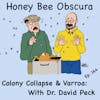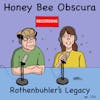Should You Paint Your Hive? (117)

You've spent lots of money on your woodenware and you want it to look good, last many years, and be safe for your the honey bees and the environment. What are your options? In today's episode, Jeff Ott (from ) joins Jim Tew to discuss the topic of...
 You've spent lots of money on your woodenware and you want it to look good, last many years, and be safe for your the honey bees and the environment. What are your options?
You've spent lots of money on your woodenware and you want it to look good, last many years, and be safe for your the honey bees and the environment. What are your options?
In today's episode, Jeff Ott (from Beekeeping Today Podcast) joins Jim Tew to discuss the topic of what to paint your hive with before your bees arrive. You have many options: latex, enamel, stain, beeswax and resin... or nothing at all. Jim and Jeff discuss these and share their experiences and preferences.
What do you do? How do you protect your investment in woodenware? Listen today and compare your answer to ours!
___________________
Thanks to Betterbee for sponsoring today's episode. Betterbee’s mission is to support every beekeeper with excellent customer  service, continued education and quality equipment. From their colorful and informative catalog to their support of beekeeper educational activities, including this podcast series, Betterbee truly is Beekeepers Serving Beekeepers. See for yourself at www.betterbee.com
service, continued education and quality equipment. From their colorful and informative catalog to their support of beekeeper educational activities, including this podcast series, Betterbee truly is Beekeepers Serving Beekeepers. See for yourself at www.betterbee.com
______________________
Honey Bee Obscura is brought to you by Growing Planet Media, LLC, the home of Beekeeping Today Podcast.
Music: Heart & Soul by Gyom, All We Know by Midway Music, original guitar music by Jeffrey Ott
Copyright © 2023 by Growing Planet Media, LLC

Episode 117 – Should You Paint Your Hive?
[music]
Jim Tew: Jeff, I grew up in my father's paint product business. He sold paints, wall coverings, carpetings, so in my earliest years I mixed paint, delivered paint, applied paint. Did everything you do with paint, dealt with people. [crosstalk]
Jeff Ott: Spilled paint.
Jim: I know a lot about paint the old way, and I know this, I don't want to paint any more than I have to. When it comes to painting my hives, I'm Mr. Efficient. Get it done. No nonsense. Get it over with.
Jeff: Yes. You're saying paint, but, so there's so many other options too, other than specific paint. Paint's a generic term and paint's a product term. There's a lot of options for beekeepers today.
Jim: [music] I'd like to talk to you about this for a few minutes to see what you do, tell you what I do and then we'll hopefully hear from some of our listeners, and find out what they do. Let's do it.
Jeff: Let's cover this world.
Jim: Oh God, that hurts. [laughs] Hi, I'm Jim Tew.
Jeff: I'm Jeff Ott from Beekeeping Today.
Jim: I want to talk to you along with Jeff about the drudgery of painting your bee equipment or not.
Introduction: [music] You are listening to Honeybee Obscura, brought to you by Growing Planet Media, the folks behind Beekeeping Today podcast. Each week on Honeybee Obscura, hosts Kim Flottum and Jim Tew, explore the complexities, the beauty, the fun, and the challenges of managing honeybees in today's world. Get ready for an engaging discussion to delight and inform all beekeepers. If you're a longtimer or just starting out, sit back and enjoy the next several minutes as Kim and Jim explore all things honeybees.
Jim: Jeff, when I go in those big-box stores that sell home supplies, it's the smell of my youth.
Jeff: Really?
Jim: I used to deliver paint to new housing subdivisions in the '40s and '50s when everybody would build, not a house, but they'd build 20 houses at one time. My dad's company would get the contract and my job is to deliver paint. You go into all that new construction work with the smell of lumber and plaster and sawdust. In those days, and then I'll stop reminiscing. You actually could hear hand saws, and you could hear men driving nails with hammers.
[laughter]
There were no women driving nails, and now all you hear is the sound of electric power saws and air nailers going on. Those are antique sounds, [sound of saw] and I would deliver paint and in those days, it was oil-based paint. It was serious stuff. You did not just go wash your hands and get that stuff off. If you got it on your clothes, you just wore it with paint on your clothes. How much and how delightfully those products have changed. Tell me what you use to paint your equipment. Right now.
Jeff: I am using two different products. I use on my white hives because I go different colors. On my white hives, I am using a latex-based paint and most of my hives are painted or protected with a colored stain.
Jim: Why did you choose stain?
Jeff: Long ago, galaxy far, far away, I had-- My good friend owned a chain of paint stores in northern Ohio and my buddy told me to use a stain because it got into the grain of wood and protected the wood better than a paint would, which just coats it and protects it from the outside.
Jim: You could argue either way. Sure. It does absorb into the wood, but it's a very thin finish. There’re no UV-inhibiting materials, so it's going to wash and wear more quickly compared to a film-based coating, like those old oil finishes that would peel in sheets, when they begin to have a product failure underneath. Yes, I use both too though. I use stain and I use latex paint. I know that if I use stain I'm going to have to go back and recoat more often.
Each time I recoat with stain, those dark spots caused by mold and mildew along the joints and wherever it's still going to be dark spots. You'll only get your most beautiful finish when that equipment is freshly painted or stained and new, so my advice to you and me both is to make a lot of photographs because as the years pass, no matter what you're painting with, it's going to get more and more beaten, even if you put on a film coat like a latex paint.
Jeff: Beauty's in the eye of the beholder though.
Jim: Yes, but I appreciate you saying that, because I think my hives are beautiful and others would think, "Oh my stars, he is one junk beekeeper."
Jeff: That is true.
Jim: Here's the bottom line. You're going to get seven years.
Jeff: Yes.
Jim: The average bee box is one that last about seven years. When I say that, I suppose people are thinking about a complete collapse and rotting away. No, I mean that the joined-up top where you use your hive tool to separate, that edge is going to begin to fail. Maybe along the bottom, there'll be some rot turning up and at that point, those who have high standards will phase it out or cut the box down and use it then as a shallower super or put a bottom on it and make a plant feeder out of it or something, so it's not going to last forever anyway.
Jeff: Let me ask you. There are so many questions on this because everybody wants their wooden wear, that's one of your bigger investments. It does have to be replaced, and so everybody wants to try to extend the life of their equipment that sits out there in on all weather and is pried on and pushed around and slammed around. That's just in the bee yard. We're not even talking about it in the shed or anything. Do you do anything special for your wooden wear when you're building it to help protect the finish ultimately? I mean, I know some beekeepers who like to apply some sort of wood preservative, eco-friendly, environmentally friendly, surface protectant to the wood before they nail it together to help protect it.
Jim: I don't do that now. When you said eco-friendly, I'm afraid that some of the things I used to do were anything but eco-friendly. There was a product called Penetrol.
Jeff: I'm familiar with it.
Jim: If it's still made, and I'm offending the Penetrol manufacturers, I am so sorry. I like the product. I didn't do anything with it that I think would have broken the code, but I don't use Penetrol anymore. It was just one more thing to do.
Jeff: Yes, I'm sorry to interrupt, but you're talking about Penetrol. I was told to mix Penetrol in with my latex paint.
Jim: All right.
Jeff: That's what I did.
Jim: Mix it in with anything. It was just a real thin oil, and it was supposed to help. When the bottom line comes around, you get to choose what you want to use. I was surprised. I'm going to use a product name Sherwin-Williams. I went over to Sherwin-Williams branch here in, in Wooster, Ohio. When I went in, like a 70-year-old guy and told them that I wanted a gallon of enamel.
They told me that by Ohio regulation, they could not sell me a gallon of enamel paint. That I could only get that at farm and big-box stores, if I could even get it there. That Ohio was discouraging the homeowner use of petroleum-based enamel paints. The most they could sell me was a quart, and-
Jeff: Interesting.
Jim: ….they didn't have it in quarts. [laughter] They promptly showed me the modern-day latex versions that are supposed to be just as resilient as the old oil finishes. I'm hammering on this. Why? Most of us, as you said earlier, want to protect that wooden investment that we have, and when that equipment comes in, it's beautiful. You can get bee equipment from all kinds of places. In fact, why don't we stop and hear from someone who'd be happy to provide all of us with such equipment?
Betterbee: [music] We're thinking spring here at Betterbee. Do you have all the hive bodies and frames you need to super up your hives or expand your apiary? If not, we have you covered with high-quality wooden wear made by our sister company, Humble abodes. Humble uses eastern white pine from the back woods of Maine to manufacture box joints that are guaranteed to fit together tightly and frame parts that are easily assembled.
Give us a call to learn more about any of our products or to ask a beekeeping question. We've got you covered. Shop for wooden boxes and frames@betterbee.com/wood.
Jim: The big thing Jeff, about any kind of protective coating, and this isn't so much a paint issue as a wood issue, was the oddity that we have, that we put living animals inside this box, and we don't want to paint the inside of the box. We want it wholesome and clean and natural by our standards. I understand that, but by putting that moisture-producing animal, our bee cluster, inside that box, they generate moisture and that moisture then percolates through the wood, and the outer finish fails not from the outside, but from that water percolating through the wood from the inside.
Beekeepers were always told and at the time I agreed, "Don't paint the insides of your boxes." Most beekeepers didn't. I still don't but I would paint them if I had to. I would paint the inside. From a paint perspective that's going to give the most protection to that bee box. I can see people rolling their eyebrows right now, furrowed brows.
Jeff: I was just going to say-
Jim: Well, you know, anything you put inside the beehive you're going to get in your honey, and no doubt you are. Once that latex finish is cured not just dried, drying and curing or two different things. Once it's cured, it is essentially inert. If anybody rushes out and paints the inside of their equipment because Jim Tew said so, and that's the only place you got your information, that's the wrong thing to do.
From a wood standpoint, protecting it should include being painted inside. From a beekeeper wholesomeness standpoint, you probably want to say, "Well, maybe it'll rot a year earlier, but so what? I'll have a better product because of it." Go ahead. Argue with me. Shoot holes in that or back it down.
Jeff: I will tell you I've never painted the inside of a box. Never and just because I grew up in the time when you don't paint the inside of the box. I've never even considered it. I will consider it next time, but I probably still won't because there's so many different philosophies now. The other is to provide a very rough interior surface for the bees to deposit propolis.
Jim: Yes, on both counts.
Jeff: If you go and paint it, are they more inclined or less inclined to deposit propolis? You take that or if you leave it rough, if you rough it up and then paint it, are they still-- That's an interesting proposition. I don't have an answer for-- I probably still will not paint the inside of the box just because old habits,
Jim: I wouldn't paint the inside of the box for a totally different reason.
Jeff: Why is that?
Jim: It's not old habits. It's because I'm an old man. Painting the outside of the boxes is enough. Figuring out how to paint the top and bottom edge is just so annoying because you get paint strips everywhere while you're trying to paint those edges. Now, let's paint the inside also. No, I'm not painting the inside but it's for lazy reasons, not because I'm really concerned about it.
Truthfully, if the bees stay in that box long enough, they will, in their own way, apply a protective finish, over the inside of the equipment. That probably is just as good, better than that latex paint film that I would've put on. It takes them a year or two to really bring in enough propolis to walk over it with wax, dirty feet, whatever they're doing to get that propolis/wax coating inside.
Jeff: This really does raise the other question about, and we've talked about stains and paints and latex paints versus enamel paints and all this real briefly, but there is a school of thought of coating or protecting the wooden wear with dipping it in wax.
Jim: Yes.
Jeff: I've never experimented with that. Have you?
Jim: I have not. However, I was very close to someone who did. In my lab, years ago, I had a technician who really took this seriously. He bought rosin from pines, coniferous trees from Mexico. He bought blocks of rosin. He melted that and a petroleum base and then added beeswax to it. He dipped our new equipment in that scathing solution. I would never recommend this. It was a double, double toil and trouble thing around that cauldron with that fire going and that boiling rosin.
He got this odd finish that permeated everything especially those box joints. You just can't get paint in those box joints. You dropped that stuff in boiling rosin-wax mix and it was absorbed into everything. We had this muddled looking equipment that sat there, forever being ugly, but being weather resistant. I would never do that because of the effort that it took to do it.
Jeff: This is definitely not something you wouldn't want to do with your spouse's Crockpot.
Jim: No, it is not.
Jeff: You could use single-use appliance.
Jim: No, I'm inclined to try, I'm that kind of person. [laughter] Why would you say that? I got a Crockpot right now that I've dedicated to wax. Whenever I dip queen cups, I fire off at old Crockpot and then wait for it to melt. There is one other thing, one other option that we have not discussed. Here it is. Just don't do anything. Put your equipment together. Put bees in it and wish it well. Over time, just like cedar, it goes from pinewood to this ashen gray silver-colored stuff. I don't have any data, but I bet you, it still lasts five to six years.
Jeff: Perhaps.
Jim: If you wanted this stuff to go 20 years you got to paint it and keep it out of the weather as much as you can. If you're prepared to buy new equipment, every 7 to 10 years just put it on. If looks count to you, then this is going to definitely be downgraded. This is not going to have the neat, wholesome white look that beekeepers like so much. There's nothing wrong with not painting it at all. It's just more correct attractive if that's a word to use here. To put some protective finish on it.
Jeff: Yes. The bees don't care. No, ultimately whether what you're doing. I think this is a different topic, but I think having different designs on the front of the hives help bees orient to your colony or to the box. The color, I'm sure you can determine while the bees don't see red, so don't paint your colony red, they'll just fly right by it. Or you might want to do it, they see more on the purple end. Paint them purplish if you want to do purple.
Jim: The color issue is a good thing though. That's an interesting topic. What color do you paint it? Number one, paint it whatever color you want, that you like. Number two, paint it bright primary colors because we like to think as beekeepers, that helps the bees orient and find their proper hive. That means you can't move supers about, and you can't reverse deeps.
I never really put a lot of credence in that. I like the brightly colored yard. I like the decals on the front. I don't do it. I admire people who can do it. The color thing, yes bees definitely see color and they don't see red apparently, as we do. They see it as something, they don't see it as invisible. It may not look red to bees, but it has a color they can identify. When it comes down to color, paint it whatever color you want. I wouldn't recommend black, especially in the Southern states and the Western states because of the heat.
Jeff: You're asking about colors? I've always-- I shouldn't say, oh always. My primary color for hives is a brown, darker color in the Pacific Northwest. Just because I think we have longer cooler days than we did in Ohio or in Colorado. Yes, so I keep it the stain brown color plus it hides it from the roadside. I don't like to see it, have my hives seen from the road. That's a personal preference.
Jim: You were taking the words from my mouth as I waited for you to politely stop, so I could jump in and say, sometimes you don't want to paint those things white because out of sight out of mind. If you've lived in an area where hives have been stolen or vandalized, then don't paint them nice bright clear colors, paint them earth-tone colors and see if they'll blend in better and not be so readily attractive to near to well people.
Jeff: I agree. I do put symbols or simple symbols blocks, squares, circles, something. I paint them, stencil them on the front of the hive. Near the hive entrance. I know that's goofiness, but I think that helps with drifting and- [crosstalk]
Jim: I dont think is goofy. I still brand mine. I've got a brand that I bought years ago, and I've marked my colonies just like it's going to prevent anybody from taking them. It's just busy work. If someone's going to steal it, they'll steal it and take a grinder and grind my name off and that's the end of that. At least, I'm making these things unstealable because I branded my name on them. This is my hive; this is my mark.
Jeff: I've got to ask you, did you find that branding iron on a roadside or in a pile of trash somewhere in Medina, Ohio area? I don’t know about 30 years ago in a pile of other beekeeping equipment that I don't want to go down that road too far, but I know I had one at one time, but it got disposed of rather.
Jim: No, I didn't. I paid hard cash for mine.
Jeff: [laughs]
Jim: We're really off the subject on branding but you get one shot. I mean, if you touch that branding iron to that box and you say, "Oh, that's not level," well you can't change your mind. You're going to spend the next 15 years with the branded box, on which your name wasn't level on. That's enough about that though. I will add this, brand equipment when it’s new. Don't try to brand on top of the paint. It never works as well if you've painted two coats of anything and then try to brand it after the fact. Brand it first and then paint it.
Jeff: My last comment on this whole topic is that many of the manufacturers, including the sponsor of the podcast, provide pre-painted boxes as well. That especially, in honey supers saves a lot of time when you need it quickly.
Jim: Yes. One thing we have not mentioned at all, and it's too late to get excited about it, is you can get a lot of equipment now that's not made of wood. It's different plastic composites and especially, if it's expanded types of polystyrene that really needs to be painted and probably should be painted inside, so the bees won't cut it and chew it so badly. Maybe resist not just wax moths, but carpenter ants that just go crazy for some of my insulated equipment.
That's a painting issue for completely different reasons, it's not wood. Anyway, this is what I think we've said. Paint with stain. There are all kinds of stains. UV inhibiting stains. Be prepared to paint more often or to apply the stain more often. Use latex.
Jeff: I use deck stain because it's tougher. Anyways, go ahead.
Jim: Use latex because you probably can't get oil paint and I'm not sure you want to use that anyway.
Jeff: No.
Jim: Don't do anything or do it one time and never do it again. Use any color you want, probably other than black. You have a lot of leeway here, don't you Jeff?
Jeff: Yes, you do.
Jim: We've talked 20 minutes and I'm not going to make a recommendation as we wind down here.
Jeff: Well, we stated our preferences, sir.
Jim: I stated my problems. I enjoyed talking about them. Thanks for letting me walk down memory lane and go back and look at equipment that needs painting, but it'll never get to it.
Jeff: Thanks for inviting me along today. Bye-bye.
Jim: All right. Bye-bye.
[00:22:57] [END OF AUDIO]
New to Honey Bee Obscura Podcast?
Here are some great episodes to start with. Or, check out episodes by topic.













